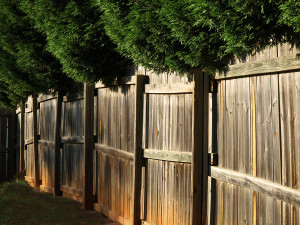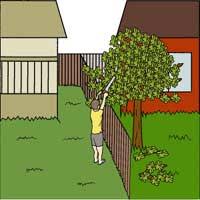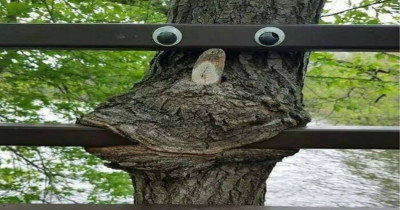
What are your rights when it comes to the neighbour’s trees?
Knowing your rights when it comes to trees can save you a lot of hassle down the line.
They help protect our privacy, provide homes for our feathered friends, and they’re perfect possies for kids’ huts. Many of us don’t give trees much thought until they’re someone else’s – and impacting on your property.
Roots dislodging your foundations. Leaves blocking your gutters. Your million-dollar view turns into a leafy hundred-dollar view, lowering the value of your home while raising your blood pressure.
Trees can cause neighbours considerable distress, particularly when they belong to the friendly folk over the fence, so what are your rights when it comes to the neighbour’s trees?

Wooden fence with green overhanging trees
01
Go straight to the root of the problem
To address any kind of tree-related tension, talk to your neighbours first. As frustrating as their trees might be, they may have no idea that they’re even an issue. So give them an opportunity to fix the problem themselves.
It’s your right as a landowner to enjoy your property. However, your neighbours have this right too. Therefore, no property owner is allowed to take matters into their own hands unless the tree is on their property.
You do, however, have the right to trim any branches from a neighbour’s tree that hang over your property; this is called ‘abatement’.
02
Resolving disputes
To address any kind of tree-related tension, talk to your neighbours first. As frustrating as their trees might be, they may have no idea that they’re even an issue. So give them an opportunity to fix the problem themselves.
It’s your right as a landowner to enjoy your property. However, your neighbours have this right too. Therefore, no property owner is allowed to take matters into their own hands unless the tree is on their property.
You do, however, have the right to trim any branches from a neighbour’s tree that hang over your property; this is called ‘abatement’.

03
Cutting down a tree
Some trees are protected by the council for reasons including species, height or heritage.
Our New Zealand natives are precious so even if your neighbour agrees to remove a tree that’s bugging you, they may not be able to legally.
Always seek specialist council or arborist advice before cutting down a tree – you can ask Neighbourly.co.nz for a recommendation of a good local arborist that you can approach.

04
Who pays?
The general rule of thumb is that if a tree is on your neighbour’s side of the fence, it’s their responsibility to pay for any damages caused to your property. If it’s on the boundary, you may need to split the cost.
You’re legally allowed to trim branches and roots from your neighbour’s tree if they have inched over to your property, however, it’s unlikely that you’ll be able to claim back any costs incurred.
If the tree is causing a nuisance rather than damage (such as blocking light or restricting views) the owner of the tree may still be liable to pay for costs to rectify the situation.
For more information about rights when it comes to your neighbours’ trees, contact your local council directly……….
Continue reading from the source Stuff

.
.
.
.
.
.
.
.
Disclaimer: The real estate content shared on this blog is intended for general informational purposes only and industry observations. The content may reflect personal views or reference third-party sources, but it is not a substitute for tailored professional advice. Real estate decisions often involve legal, financial, and regulatory complexities, and readers should seek independent guidance from qualified specialists such as legal advisors, financial consultants, or compliance professionals before acting on any information presented here. No warranty is given as to the accuracy, completeness, or current relevance of the material.




